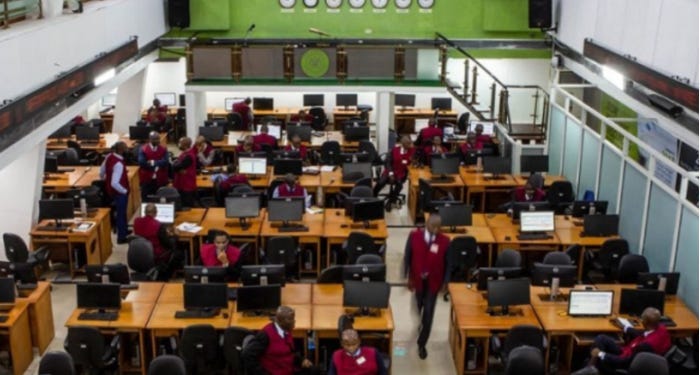Afrinvest Monthly Update | Domestic Equities and Fixed Income Round Up
An Extraction of the Afrinvest Monthly Economic & Market Report for January, 2024
Photo Credit: NGX
In the first month of the year, the NGX sustained the 2023 bullish momentum with a m/m gain of 35.3% to 101,154.13 points as investors showed enthusiasm ahead of earnings season. As such, YTD return printed at 35.3% while market capitalisation advanced ₦14.4tn to ₦55.4tn. Monthly trading activity surged as average volume and value traded rose 98.2% and 67.1% m/m to 875.9m units and ₦14.8bn, respectively. TRANSCORP (1.6bn units), UBA (1.2bn units), and ACCESSCORP (985.8m units) were the top traded stocks by volume for the month, while DANGCEM (₦62.8bn), UBA (₦35.0bn), and ACCESSCORP (₦27.9bn) led by value.
Across our sector coverage, performance was positive as all indices gained, save the Banking index which lost 3.4% following losses in GTCO (-8.6%) and FBNH (-7.9%). Leading the gainers’ pack, the Industrial Goods index posted the biggest gain of 107.9% on the back of strong buying interest in DANGCEM (+138.5%) and BUACEMENT (+90.7%). Following suit, the Consumer Goods and Insurance indices rose 24.3% and 21.7% m/m respectively, driven by price appreciation in BUAFOODS (+40.5%), PZ (+24.0%), LINKASSURE (+46.3%), and AIICO (+35.0%). Similarly, the Oil & Gas and AFR-ICT indices appreciated by 20.0% and 6.2% m/m due to gains in ETERNA (+58.5%), SEPLAT (+33.1%), and MTNN (+6.4%).
Investor sentiment, as measured by market breadth, improved to 1.4x from 1.0x recorded a month ago as 81 stocks gained, 29 lost while 38 were unchanged. The top performing stocks for the month were DANGCEM (+138.5%), BUACEMENT (+90.7%), and MCNICHOL (+89.3%), while DAARCOMM (-25.6%), CHAMPION (-14.9%), and TANTALIZER (-10.6%), were the top underperforming stocks. In In February, we expect a mild market correction on the local bourse, owing to a mix of profit taking activities and earnings season frenzy.
Foreign Exchange Market: Naira Downward Trend Deepens across Segment
Global crude oil price rose in January with benchmark Brent experiencing a 4.4% m/m increase to $80.55/bbl., with ongoing geopolitical tensions being majorly responsible for surge in oil price. However, traders would remain cautious ahead of OPEC+ meeting in March, given the US Feds decision to hold rates steady at its recent FOMC meeting.
On the domestic scene, CBN foreign reserves gained 1.5% m/m in January to close at US$33.4bn. The accretion in reserves might not be unconnected to inflows of about $3.3bn from the Afrexim bank crude-oil-tied support facility. Meanwhile, in the currency market segment, the naira witnessed a downward trend in both the official and parallel market segments. At the NAFEM window, the base currency (USD) appreciated 37.7% m/m against the price currency (Naira) to exchange at ₦1,455.59/$1.00 at the end of January while at the parallel market, the USD appreciated 21.1% m/m against the Naira to exchange at ₦1,515.00/$1.00 - bringing the parallel market/official rate differential to below 5.0% (previously above 30.0%). This came on the back of multiple policy measures by the CBN in the month. Likewise, daily average turnover in the NAFEM window tapered 22.4% m/m to settle at $104.9m in January. Looking ahead to February, we anticipate that the Naira would remain pressured across market segments though ongoing stop-gaps should temper the pace.
Bonds Market: Weak Outing in the Local Bonds and SSA Markets while Corporate Eurobond Space Return Positive
Activity in the sovereign bonds market this month was directed by the flow of liquidity - coupon payment (₦289.6bn), T-Bills maturity (₦288.4bn), CBN’s FX backlog clearance ($500 million) – and rate expectations at the January auction. At the auction, the Debt Management Office (DMO) reopened the FGN MAR 2027, APR 2029, JUN 2033, and JUN 2038 bond instruments. Of the ₦360.0bn offered, ₦418.2bn was allotted following strong subscription of ₦604.6bn which put bid-to-cover ratio at 1.4x (December: 3.2x). Marginal rates for the MAR 2027, APR 2029, JUN 2033, and JUN 2038 bonds remained at previous level at 15.0%, 15.5%, 16.0% and 16.5% respectively.
In the secondary market, sell pressure dominated on 11 of the 22 trading days which weighed on performance as average yield rose 42bps m/m to 14.3%. Across the term structure, the short and medium-end instruments recorded the selloffs as average yield rose 89bps and 79bps m/m respectively while yield on the long-term instruments dipped 12bps m/m.
The SSA Eurobonds market was shaped by skepticism around the Fed potentially cutting rates, headway in Ghana’s debt restructuring and Kenya’s $684.7m loan from the IMF to settle its 2024 paper. Nevertheless, negative sentiment pushed average yield higher by 191bps m/m to 27.0% largely due to sell-offs in the ZAMBIA 2024 (+71.4ppts) and GHANA 2025 (+14.0ppts) instruments. Conversely, maturing SOUTH AFRICA 2024 and GHANA 2026 instruments posted gains, with yield declining 34.4ppts and 4.2ppts m/m respectively. Investors' appetite for African Corporate Eurobonds improved as average yield rose 36bps m/m to 8.5% due to demand for FIDELITY BANK and EBN FINANCE 2026 instruments as yield went down 123bps and 182bps m/m respectively.
For February, we expect the bearish momentum to persist in the domestic bonds market following weak liquidity inflow (FEB:₦357.6bn vs JAN:₦578.0bn) and continuous repricing amid anticipation of MPC decision. Meanwhile, in the Eurobond Markets, the weak pursuit for attractive yield is anticipated to drive a negative performance.



